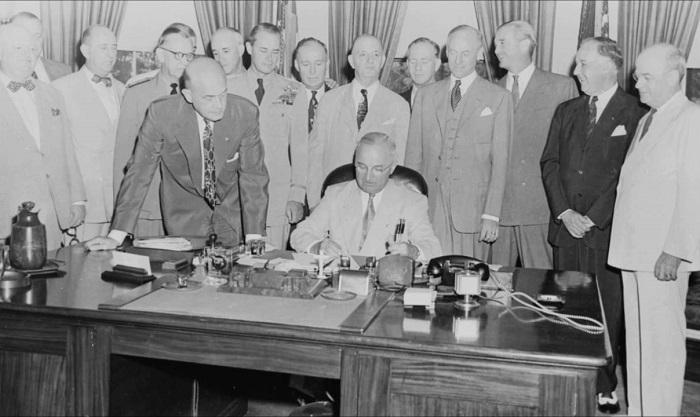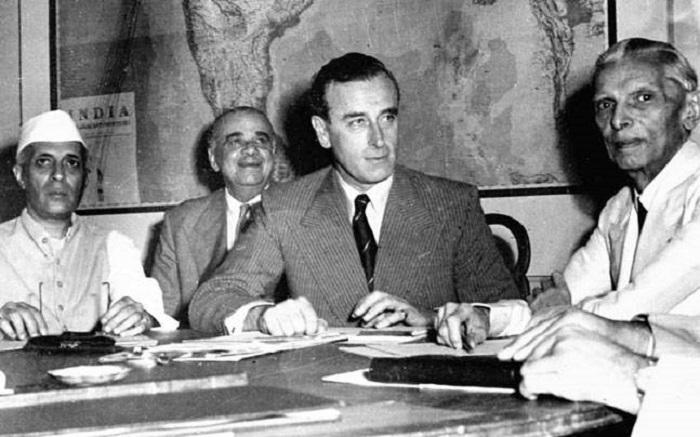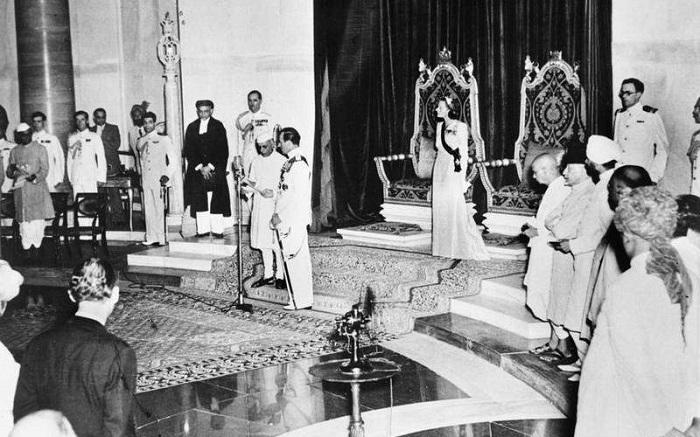The ‘Parliament of the United Kingdom’ passed the ‘Indian Independence Act’ 1947, which was sanctioned by the British crown on July 18, 1947. The act was one of the final formalities that had to be completed before the inevitable split of British India, which would give rise to Pakistan on August 14 and to the dominion of India on August 15. The act was the direct result of the ‘3rd June Plan,’ which was proposed by Lord Mountbatten. According to what was also known as the ‘Mountbatten Plan,’ the British Government was in accordance with the partition of British India and that the two governments thereafter would be granted dominion status.
Background
Clement Richard Attlee, who had assisted Sir John Allsebrook Simon in the famous ‘Simon Commission,’ had become the Prime Minister of the United Kingdom in 1945. Since Clement Attlee was always an advocate of free India, he played a key role in the eventual formulation of the act. On February 20, 1947, Prime Minister Attlee came up with an important announcement. According to the announcement, the British Government would likely grant India the power to form its own self-government by June 1948. Attlee’s announcement also stated that the date for the final transfer of power will be decided first, post which a call would be taken to decide the fate of the Princely States. On March 18, 1947, Clement Richard Attlee wrote a letter to the then and last Viceroy of India, Lord Mountbatten. In the letter, he had mentioned that His Majesty’s Government’s intention was not to bring paramountcy as a system. He also stated that Lord Mountbatten was authorized to take a call while entering into negotiations with the Princely States of India.
On June 3, 1947, the government of British proposed a plan, which later came to be known as the ‘Mountbatten Plan’ as it was proposed by Lord Mountbatten. The ‘3 June Plan’ stated that the British Government was in accordance with the partition of British India and that the successive governments would be granted dominion status. The plan was forwarded to the ‘Indian National Congress,’ Head of the Sikh community in India, and the ‘All-India Muslim League.’ Once the plan was approved by all the three factions, the legislation for the ‘Indian Independence Act’ was formulated by the then Governor General of India, Lord Mountbatten and the then Prime Minister of the United Kingdom, Clement Attlee. On July 18, 1947, the ‘Indian Independence Act’ was sanctioned by the British crown, before being passed by the ‘Parliament of the United Kingdom.’

Image Credit : https://www.youtube.com/watch?v=XL1Yvxyyo3w
Provisions of the Indian Independence Act, 1947
There were six primary provisions in the ‘Indian Independence Act’ 1947.
- The first provision stated that British India will be divided into two fully sovereign dominions of Pakistan and India and that the newly formed dominions can form their own government with effect from August 15, 1947.
- The second provision stated that the provinces of Bengal and Punjab will be divided between the two newly created countries. It also indicated that Western Punjab, Eastern Bengal, North-West Frontier Province, and Sindh would be given to Pakistan.
- The third provision made sure the Crown continues its authority in some form or the other; it stated that the office of the Governor-General will be established in the newly formed countries. It also stated that it was not mandatory for India or Pakistan to become a member of the ‘British Commonwealth of Nations,’ but the Governor-General will be assigned the responsibility of being the representative of the Crown in both the nations.
- According to the fourth provision, complete legislative authority will be conferred upon the respective Constituent Assemblies of both the newly created countries.
- The fifth provision was the most important provision for the Princely States of India and Pakistan as it decided the fate of the Princely States. According to the provision, British suzerainty would be terminated over the princely states on August 15, 1947. It further added that the British government recognizes the rights and free will of the princely states to either join one of the two new dominions or remain independent if they wish to run their own government.
- The next provision stated that the British monarch can no longer use the title the ‘Emperor of India.’ On June 22, 1948, King George VI announced his royal proclamation, which said that no British monarch can be conferred with the title ‘Emperor of India’ with effect from June 22, 1948.

Image Credit : https://www.indiatoday.in/education-today/gk-current-affairs/story/indian-independence-act-329774-2016-07-18
Apart from the six most important provisions of the act, there were other provisions too, which were made to tackle other prominent obstacles, including the division of joint property between India and Pakistan. The joint property included the armed forces of the British India, which was later divided according to the provision. The provision also stated that the members of the armed forces would continue to enjoy the same rights and privileges pertaining to their remuneration, pension, etc.
Features of the Indian Independence Act, 1947
A set of laws and regulations were written down in order to make sure the newly created countries do not face any confusion with regards to the demarcation of territories. While the first and foremost salient feature of the ‘Indian Independence Act’ 1947 is about the creation of two new dominions, it should also be noted that the creation of new dominions was in accordance with the desires of Hindus and Muslims to rule themselves by forming self-governments.
After zeroing in on August 15, 1947 as the designated date for the partition, the act then addressed the demarcation of territories. In order to create Pakistan, Bengal had to be divided, which marked the end of the province as constituted under the 1935 ‘Government of India Act.’

Image Credit : http://www.quithatemovement.org/quit-india-movement-1942.html
While dividing Bengal, the fate of Sylhet was left to hang in the balance as it was decided that decision pertaining to the constituent of Assam will be made in a referendum later.
Similarly, the fate of North West Frontier Province too was left to hang in the balance. While dividing the Punjab, it was stated that Punjab as constituted under the 1935 ‘Government of India Act’ no longer exist. Instead, two new provinces, namely East Punjab and West Punjab were to be created.
Another important feature of the act was the appointment of a new commission called the ‘Boundary Commission.’ The commission, which was to be appointed by the Governor General, would be responsible in creating boundaries of the newly created nations. This feature was the basis of what was later known as ‘Radcliffe Boundary Commissions’ as it was headed by Sir Cyril Radcliffe.
The act also mentioned that the two new dominions will be temporarily governed according to the ‘Government of India Act’ 1935 until India and Pakistan come up with constitutions of their own. Apart from designating the ‘Government of India Act’ 1935 to help govern the newly created countries, the British administration also decided that it would appoint a Governor General in both the dominions. The primary responsibility of the Governor General was to preside over the division of territories, rights, duties, powers, liabilities, assets, etc. The Governor General was also empowered to adopt and amend the ‘Government of India Act’ 1935.

Image Credit :https://www.firstpost.com/photos/images-how-india-ushered-in-its-first-independence-day-418724.html
The legislative setup that was already in place was allowed to continue as a legislature as well as the Constitution making body. The legislature was assigned complete power to make and change laws, including those involving extraterritorial operation. However, the Governor General still had complete power to give assent to any given law of the legislature. The act also mentioned the consequences of setting up new dominions.
Some of the most important consequences were the lapse of British suzerainty over Indian States, the lapse of treaties with the Indian States, and the abolishment of the post of the Secretary of State.
In addition to the above mentioned features, a couple of important schedules were added in the act. According to the first schedule, four divisions, namely ‘Chittagong Division,’ ‘Dacca Division,’ ‘Presidency Division,’ and ‘Rajshahi Division’ were added in the province of East Bengal. Each one of these divisions housed various districts, which now belonged to East Bengal. Under this schedule, districts that went to East Bengal include Noakhali & Tipperah, Chittagong Hill Tracts, Districts of Chittagong, Faridpur, Mymensingh, Kustia and Meherpur Tehsils, Districts of Bogra, Dinajpur, and Rangpur & Nawabganj Tehsil, etc.
Under the second schedule, three divisions, namely ‘Lahore Division,’ ‘Rawalpindi Division,’ and ‘Multan Division’ were added in the province of West Punjab. Districts under these divisions include Districts of Gujranwala, Sheikhupura, Sialkot & Shakargarh Tehsil, Lahore, Districts of Attock, Jehlum, Shahpur, Rawalpindi, Districts of Dera Ghazi Khan, Lyallpur, Jhang, Multan, Montgomery, and Muzaffargarh.


